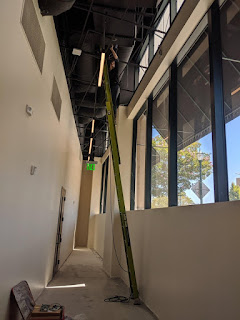I can't remember where I found the book that extolled the virtues of "planning for failure". The author wasn't suggesting we plan to fail, but rather, that being willing to experiment, or to learn from our mistakes, is a tremendous asset. As in, when you start a new project, build in time for reflection and learning so that the next round is better.
And so. I decided that making a bicycle wheel chandelier would be a great opportunity to plan for failure -- or rather, to plan to learn from my failures, so I could get better and better.
Why a bicycle chandelier? Our new living room came with gobs of natural light, but basically zero electrical light*. The room is beautiful, with 9-foot ceilings and gorgeous woodwork, ornate radiators, a handsome brick fireplace, and NO wall-mounted or ceiling mounted light fixtures. It's wonderful during the day, but as soon as the sun goes down, it becomes a bit of a cave. So we need a way to add focused light to a couple of different areas the room where we spend the most time. Table lamps with long cords to trip on just don't cut it.
 |
| My first attempt at a bike chandelier. It's ugly, but a fun kind of ugly, I think. |
* In the weird electrical wiring of ways of this house, there are actually two sockets for light bulbs on the fireplace mantel. The electrician initially told us they don't work: they do, actually, and there are four (4!) different light switches that control this pair of sockets. The two switches at different ends of the living room make sense, but the switches in the dining room and upstairs hallway do NOT -- especially because those switches both override the living room switches, so if you turn off the lights while you're in the dining room or in the upstairs hallway, people in the living room can't turn them back on. So weird.
So. I decided to look for ceiling fixtures. Not surprisingly, these are super pricey (think $200-$1000 each), even without considering adding in the work of running wires through the wall and installing proper receptacles on the ceiling. So, I decided to stop looking at ceiling fixtures, and to make my own. This way I could experiment easily with amount of light, placement of the fixtures, and style. Plus, I'd get to learn a bit along the way.
- I bought 5 different wheels from a bike salvage store for $5 total.
- I bought two ugly lamps, a large bunch of LED bulbs, and some extension cords (to use for wiring) from our local Habitat Restore. In the same store, I also got a few supplies for other projects, and I ended up spending about $46 on everything together.
- While I was on that trip, I stopped at a yard sale and got 4 milk jugs for a quarter apiece; since I can return them to our market milk stand for $2 each, this is like spending negative $7.
- At some point, I needed to buy a bunch more cord from the hardware store; 30 feet of lamp wire ran about $10.
 |
| This circular chandelier (on its side) was the raw material for one of my new fixtures. |
For the purposes of transferring sockets plus wires to a bike wheel, circular chandeliers are somewhat preferable to long wall fixtures. One reason is that the wires attached to sockets in a circular fixture are all the same length, so they all met at the middle of the bike wheel when I moved them to their new home. On the other hand, if you want fixtures for regular bulbs (not skinny chandelier bulbs), then it's totally doable to use the long rectangular kinds, which are much more likely to have the kind of fatter socket you want. It just gets a little uglier, because the wiring connectors will be a little off-center in the bike chandelier.
 |
| This long wall-mounted fixture has sockets for regular-sized bulbs. |
 |
| The back of the wall-mounted fixture. Notice that the wires from the sockets are different lengths. That will affect aesthetics, but not function, in the bike version of the lamp. |
What else? Oh, let's see. To get the store-bought fixtures taken apart, mostly I just needed a wrench. But with the larger sockets, I wrenched around fruitlessly for a while before I realized there's a little screw inside the socket that attaches the socket to the fixtures.
 |
| Removing the socket from the gold-colored fixture. |
 |
| Voila: a chandelier knob on a bike wheel. I still can't quite believe how sweet that is. |
Other things I learned: it's hard to buy the kind of switch that goes right on the cord. Our hardware store sells them for $5 a piece; never mind THAT! I will probably find some old desk lamp that someone is tossing and scavenge that switch eventually. Right now we're still at the "plug it in or unplug it" to turn one of the chandeliers on and off; the other one, we plug into a power strip with a switch. So we're not all the way there yet, but it keeps evolving.
I'll write in another post with a few photos of how I did this, and also current drafts of the project. But meanwhile, on to more experimenting. Failure, ho!






























